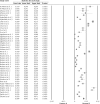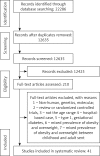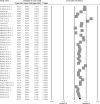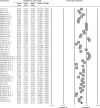Prevalence of childhood and adolescent overweight and obesity in Asian countries: a systematic review and meta-analysis
- PMID: 30393474
- PMCID: PMC6209725
- DOI: 10.5114/aoms.2018.79001
Prevalence of childhood and adolescent overweight and obesity in Asian countries: a systematic review and meta-analysis
Abstract
Introduction: We conducted a systematic review and meta-analysis to estimate the prevalence of overweight and obesity in children (aged 5-12 years) and adolescents (aged 12-19 years) in Asian countries. Study design: Systematic review and meta-analysis.
Material and methods: We comprehensively searched specialised databases for relevant studies conducted in Asian countries between January 1, 1999, and May 30, 2017. Random effects models (using the DerSimonian-Laird method) and generic inverse variance methods were used for quantitative data synthesis. Sensitivity analysis was conducted using the 'leave-one-out' method. Heterogeneity was quantitatively assessed using the I2 index. Systematic review registration: CRD42016033061.
Results: Among 22,286 identified citations, 41 studies met the inclusion criteria with n = 71,998 and n = 353,513 for children and adolescents. The pooled prevalence (overall, boys and girls) was 5.8% (n = 4175), 7.0% (n = 2631) and 4.8% (n = 1651) for obesity in children aged 5-11 years; 8.6% (n = 30,402), 10.1% (n = 17,990) and 6.2% (n = 10,874) for obesity in adolescents age 12-19 years. For overweight in children the values for overall, boys and girls were 11.2% (n = 7900), 11.7% (n = 4280) and 10.9% (n = 3698) respectively; and for overweight in adolescents, 14.6% (n = 46,886), 15.9% (27,183), and 13.7% (20,574). These findings were robust in sensitivity analyses. In children and adolescents a higher percentage of boys than girls are obese (children = 7.0 vs. 4.8%, adolescents = 10.1 vs. 6.2%, p < 0.001, respectively). Furthermore, in children and adolescents a higher percentage of boys than girls are overweight (children = 11.7 vs. 10.9%, adolescents = 15.9 vs. 13.7%, p < 0.001, respectively).
Conclusions: In view of the number of children who are overweight or obese, the associated detrimental effects on health, and the cost to health-care systems, implementation of programmes to monitor and prevent unhealthy weight gain in children and adolescents is needed throughout Asian countries.
Keywords: adolescent; childhood; obesity; overweight.
Conflict of interest statement
The authors declare no conflict of interest.
Figures









References
-
- Rivera JA, de Cossio TG, Pedraza LS, Aburto TC, Sanchez TG, Martorell R. Childhood and adolescent overweight and obesity in Latin America: a systematic review. Lancet Diabetes Endocrinol. 2014;2:321–32. - PubMed
-
- Mistry SK, Puthussery S. Risk factors of overweight and obesity in childhood and adolescence in South Asian countries: a systematic review of the evidence. Public Health. 2015;129:200–9. - PubMed
-
- Swinburn BA, Sacks G, Hall KD, et al. The global obesity pandemic: shaped by global drivers and local environments. Lancet. 2011;378:804–14. - PubMed
Publication types
LinkOut - more resources
Full Text Sources
Miscellaneous
